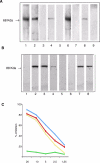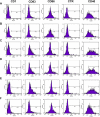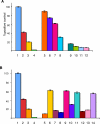In celiac disease, a subset of autoantibodies against transglutaminase binds toll-like receptor 4 and induces activation of monocytes
- PMID: 16984219
- PMCID: PMC1569884
- DOI: 10.1371/journal.pmed.0030358
In celiac disease, a subset of autoantibodies against transglutaminase binds toll-like receptor 4 and induces activation of monocytes
Abstract
Background: Celiac disease is a small intestine inflammatory disorder with multiple organ involvement, sustained by an inappropriate immune response to dietary gluten. Anti-transglutaminase antibodies are a typical serological marker in patients with active disease, and may disappear during a gluten-free diet treatment. Involvement of infectious agents and innate immunity has been suggested but never proven. Molecular mimicry is one of the mechanisms that links infection and autoimmunity.
Methods and findings: In our attempt to clarify the pathogenesis of celiac disease, we screened a random peptide library with pooled sera of patients affected by active disease after a pre-screening with the sera of the same patients on a gluten-free diet. We identified a peptide recognized by serum immunoglobulins of patients with active disease, but not by those of patients on a gluten-free diet. This peptide shares homology with the rotavirus major neutralizing protein VP-7 and with the self-antigens tissue transglutaminase, human heat shock protein 60, desmoglein 1, and Toll-like receptor 4. We show that antibodies against the peptide affinity-purified from the sera of patients with active disease recognize the viral product and self-antigens in ELISA and Western blot. These antibodies were able to induce increased epithelial cell permeability evaluated by transepithelial flux of [(3)H] mannitol in the T84 human intestinal epithelial cell line. Finally, the purified antibodies induced monocyte activation upon binding Toll-like receptor 4, evaluated both by surface expression of activation markers and by production of pro-inflammatory cytokines.
Conclusions: Our findings show that in active celiac disease, a subset of anti-transglutaminase IgA antibodies recognize the viral protein VP-7, suggesting a possible involvement of rotavirus infection in the pathogenesis of the disease, through a mechanism of molecular mimicry. Moreover, such antibodies recognize self-antigens and are functionally active, able to increase intestinal permeability and induce monocyte activation. We therefore provide evidence for the involvement of innate immunity in the pathogenesis of celiac disease through a previously unknown mechanism of engagement of Toll-like receptor 4.
Conflict of interest statement
Figures










References
-
- Hadjivassiliou M, Williamson CA, Woodroofe N. The immunology of gluten sensitivity: Beyond the gut. Trends Immunol. 2004;25:578–582. - PubMed
-
- Dewar DH, Ciclitira PJ. Clinical features and diagnosis of celiac disease. Gastroenterology. 2005;128:S19–S24. - PubMed
-
- MacDonald TT, Monteleone G. Immunity, inflammation, and allergy in the gut. Science. 2005;307:1920–1925. - PubMed
-
- Rewers M. Epidemiology of celiac disease: What are the prevalence, incidence, and progression of celiac disease ? Gastroenterology. 2005;128:S47–S51. - PubMed
-
- Rostom A, Dube C, Cranney A, Saloojee N, Sy R, et al. The diagnostic accuracy of serologic tests for celiac disease: A systematic review. Gastroenterology. 2005;128:S38–S46. - PubMed
Publication types
MeSH terms
Substances
LinkOut - more resources
Full Text Sources
Other Literature Sources
Medical
Research Materials
Miscellaneous

